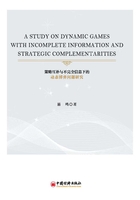
Preface
This book consists of three essays that adopt both theoretical and empirical methods of analysis to study certain economies in which the incomplete information and the strategic complementarities between players are important.
Chapter 1 explains the topics discussed in the subsequent chapters and gives a brief survey on the literature.
In Chapter 2, I revise a traditional global game model by dividing the continuum of players into a group of speculators and a group of stakeholders. It is found that the uniqueness property remains in the new game. Then I extend the static game to a two-stage game and investigate the efficacies of certain label changing mechanisms proposed by the authority to stabilize the regime in the dynamic context. It is shown that a label changing mechanism allowing for downward social mobility may not work, whereas a label changing mechanism allowing for upward social mobility generally makes the regime more stable.
In Chapter 3, I add a speculator and an authority to a bank-run model to investigate how the speculator endangers a business or an economy, and what the authority can do about it. In particular, I show that the speculator can increase the financial system's vulnerability by serving as a coordinating device for the investors and thus triggering the crisis. It is further shown that deterring the speculator may not undo the speculator's impact because of multiplicity problem; rewarding holding investors is useless; and eliminating the preemption motives among investors works given enough effort. A discussion of the 1997 Asian Finan-cial Crisis and the IMF's role is also included.
Chapter 4 develops a repeated beauty-contest game to investigate the effect of previous winners' actions on the spread of subsequent players' actions. I first characterize the unique equilibrium of the game. Then I focus on the equilibrium dynamics of several variances depicting different forms of action variability. It is found that whether or not a specific variance diminishes over time depends on the relative precision of public and private signals. To illustrate the theoretical results, I conduct an empirical study on the Miss Korea contest. It is found that the contestants' faces have been converging to the "true beauty" overall, but diverging from each other over 1994-2013.Chapter 5 concludes.